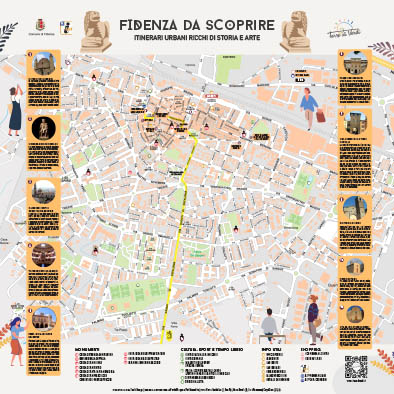Fidenza: “Everything you wouldn’t expect”. It is a city of art and culture, forming the central point along the Via Francigena. It was once called Borgo San Donnino in honour of its patron saint, and is situated between rolling hills and the lowlands of the province of Parma, as well as forming a meeting point to discover Verdi’s lands.
The cathedral in Fidenza, dedicated to Saint Domninus Martyr (Italian: San Donnino Martire), is one of the best masterpieces of Romanesque architecture, excelling for its rich bas-reliefs. It was designed by Benedetto Antelami between the 11th and 12th centuries. The façade is a stage decorated with historical figures which retell, among others, the story of the saint, and still today the cathedral forms one of the most important stages on the Via Francigena which leads pilgrims from the west of Europe to Rome. Benedetto Antelami also created the statue of the Virgin Mary with child that can be found in the Diocesan Museum, a museum which spans the seat of the Diocese and part of the cathedral, where you can visit the “Treasure of the Cathedral”, as well as other precious objects and liturgical furnishings.
The square in front of the cathedral is the departure point for an exciting walking tour of Fidenza, first visiting the nearby archaeological remains of the Roman bridge. Rediscovered in 1874, they are visible thanks to remodelling of the square. Nearby, we find ourselves in the shadow of the medieval tower, formerly known as the “Porta di San Donnino”, the only remaining trace of the old citadel. Inside we find the headquarters for the European Association of the Via Francigena ways, along with an antiquarium with some archaeological discoveries, and Casa Cremonini, the tourist information office of Fidenza.
We see further evidence of the medieval presence in Fidenza at the town hall, built between 1273 and 1354, and subsequently rebuilt in 1570. The current façade, with its crenelation, arches and porticos, was rebuilt in neogothic style in 1875 as a project by the Fidenza-born scenographer Girolamo Magnani. He was the curator of some of the most important scenes of Giuseppe Verdi’s works, as well as creator of the rich decoration of the hall and foyer of the theatre in Fidenza, which took his name in 1889.
Continuing with our wander around the streets of Fidenza, we see Baroque art becoming an ever more distinctive element. We come across the Palazzo delle Orsoline, built at the beginning of the 1700s, as a convent for the Ursuline nuns. Today it has become a home of culture: it hosts the “Michele Leoni” civic library, the “OF” (the institute of Culture and Art of Fidenza) and the Risorgimento Museum dedicated to Luigi Musini. Inside the museum we can see numerous military artefacts, as well as photographs, carvings, letters, lithographies, manifestos, prints, statues and a rare copy of Alessandro Pavia’s Album dei Mille. The building also hosts the Fossil Museum whose relics mostly come from the nearby Stirone stream.
Just a few steps later in our itinerary, we find ourselves in front of the impressive Palazzo dei Gesuiti complex. Built in the 17th century as a Jesuit convent, it was closed in 1806 following the Napoleonic suppression of religious orders, and was transformed into a hospice for beggars; it was subsequently designated as a military hospital and is currently home to several associations and offices while undergoing restoration. Along our walk, we see other religious buildings with historical-artistic importance, like the 15th century church of St Michael Archangel, the Saint George oratory, and the church of Saint Mary.
da Fidenza verso le terre di verdi
The centre of Fidenza is also a departure point for 12 outdoor routeswhich snake between the lowlands and the hills, offering us breath-taking panoramas, and snippets of culture, history and nature. Unexpected experiences are waiting for us in Verdi’s lands, like thebirth house of the Maestroin Roncole Verdi and nearby Busseto, as well as fortresses and castles, and the Abbey of Chiaravalle della Colomba, built in 1145 and still run by Cistercian monks. In the Stirone nature reserve, between paths and clearings that follow the stream, we suddenly come across small ‘canyons’ filled with fossils. To explore this more, we can visit “MuMab”, a new museum about the sea, biodiversity and fossils at the Millepioppi farm in San Nicomede.
One of the itineraries is the so-called “Shopping Way”, taking us to Fidenza Village. The shopping outlet pays homage to the artistic and musical patrimony of the area while immersing you in the best “Made in Italy” luxury shopping has to offer. From the world of fashion, we are quickly brought to the world of food and wine excellencies as we enter the Lands of Verdi, where you can undertake a tasting experience to discover local dishes, ingredients and wines.



